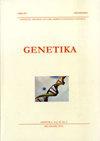Assessment of pepper genetic resources for Verticillium wilt resistance
4区 农林科学
Q3 Agricultural and Biological Sciences
引用次数: 2
Abstract
Study was carried out for determining the reaction of 83 peppers varieties, breeding lines, and local forms /landraces/ to fungal pathogen Verticillium dahliae Kleb. as they are the part of the Balkan Capsicum core collection which was deeply phenotyped in the recent years. The development of the disease was reported twice and high degree of resistance was reported for 41 accessions. The highest percentage of highly resistant group of genotypes was 72%, followed by resistant group with 23%. The infestation in the groups of medium sensitive, sensitive and highly sensitive was respectively 1%, 3%, and 1%. The highly sensitive (0 - 19%), sensitive (20 - 39%) and medium sensitive (40 - 59%) are consisted by the var. blocky, var. ratundum and var. kapia accessions. The group of resistant (60 - 79%) was dominated by var. ratundum and var. blocky. Materials from var. kapia prevail of highly resistant (80 - 100%). The group of pungent peppers accessions was more resistant to Verticillium infestation. On the base of current and previous results may concluded that four accessions were identified as resistant to TMV and non-infested by Verticillium while two ones possessed low infestation by green aphids, trips and cotton bollworm and non-attacked by Verticillium. Other seven genotypes combined lack of infestation by Verticillium wilt with high levels of three and more agronomic and biochemical traits.辣椒抗黄萎病遗传资源评价
研究了83个辣椒品种、品种系和地方品种对大丽花黄萎病菌的反应。因为它们是近年来深入表现型的巴尔干辣椒核心系列的一部分。报告了2次发病,41份材料报告了高抗性。高耐药组比例最高,为72%,耐药组次之,为23%。中敏感组、敏感组和高度敏感组的侵染率分别为1%、3%和1%。高敏感型(0 ~ 19%)、敏感型(20 ~ 39%)和中敏感型(40 ~ 59%)由块状变异、圆形变异和kapia变异组成。耐药组以大鼠变种和块状变种居多(60 ~ 79%)。材料来自var. kapia,耐高温(80 - 100%)。辣辣椒组对黄萎病的抗性较强。综合目前和以往的研究结果,有4份材料对TMV具有抗性,不受黄萎病的侵害;2份材料对绿蚜、黄萎病和棉铃虫的侵害较低,不受黄萎病的侵害。其他7个基因型不受黄萎病侵染,同时具有3种以上的高水平农艺和生化性状。
本文章由计算机程序翻译,如有差异,请以英文原文为准。
求助全文
约1分钟内获得全文
求助全文
来源期刊

Genetika-Belgrade
AGRONOMY-GENETICS & HEREDITY
CiteScore
1.80
自引率
0.00%
发文量
1
审稿时长
6-12 weeks
期刊介绍:
The GENETIKA is dedicated to genetic studies of all organisms including genetics of microorganisms, plant genetics, animal genetics, human genetics, molecular genetics, genomics, functional genomics, plant and animal breeding, population and evolutionary genetics, mutagenesis and genotoxicology and biotechnology.
 求助内容:
求助内容: 应助结果提醒方式:
应助结果提醒方式:


